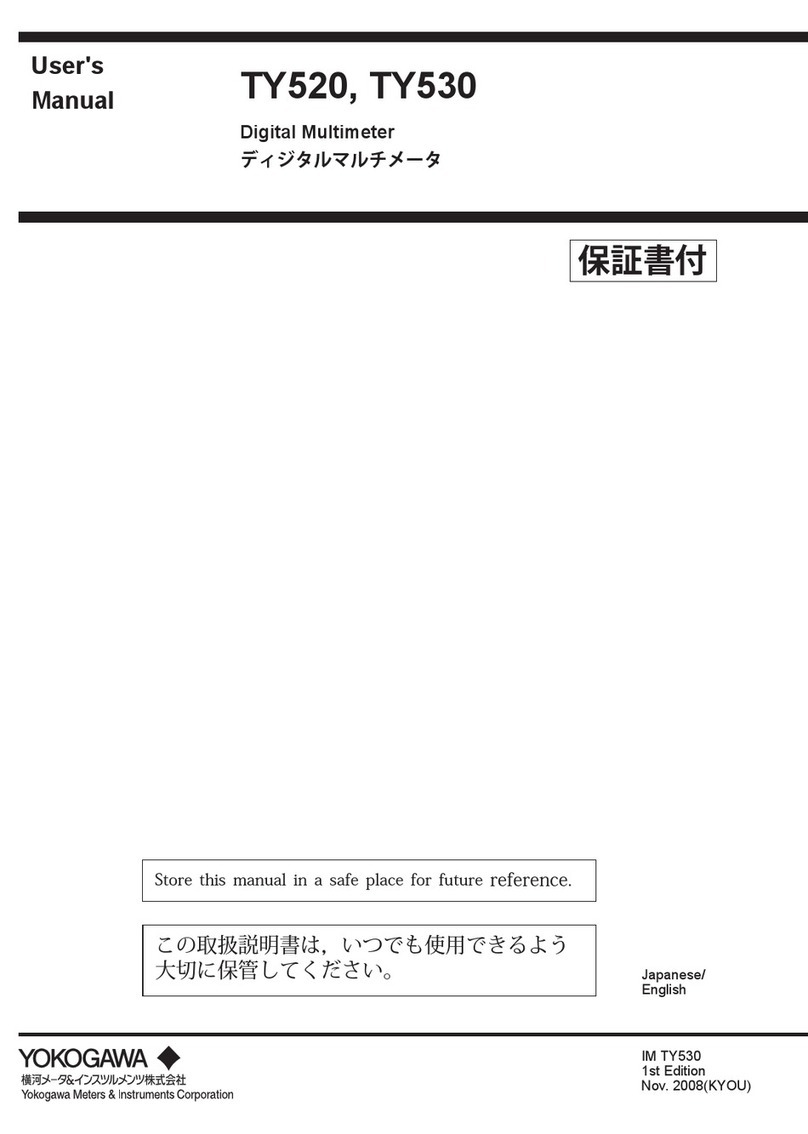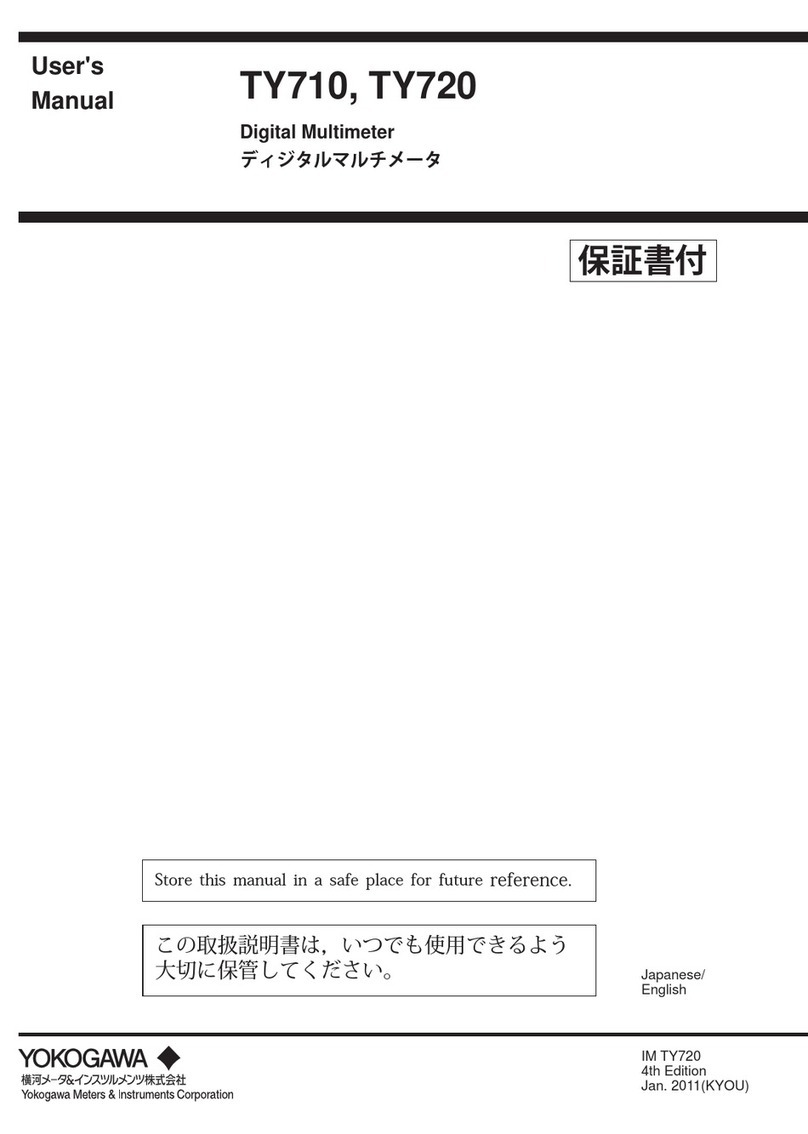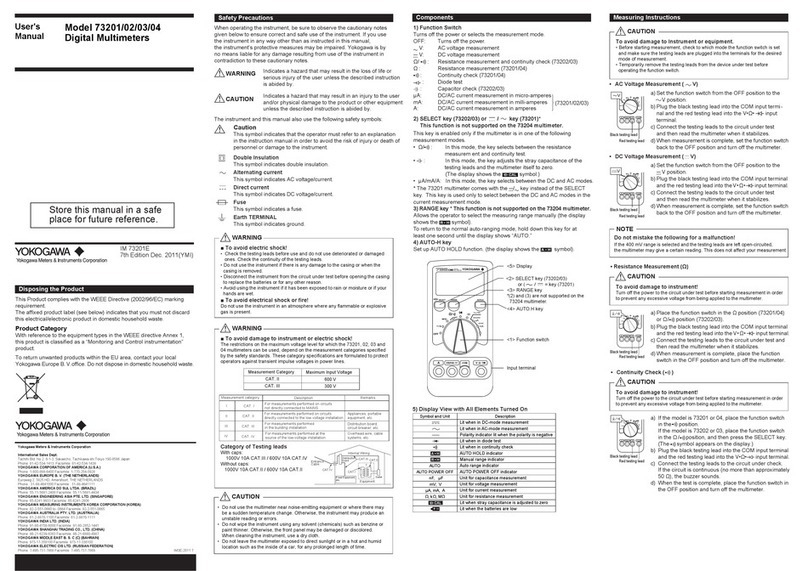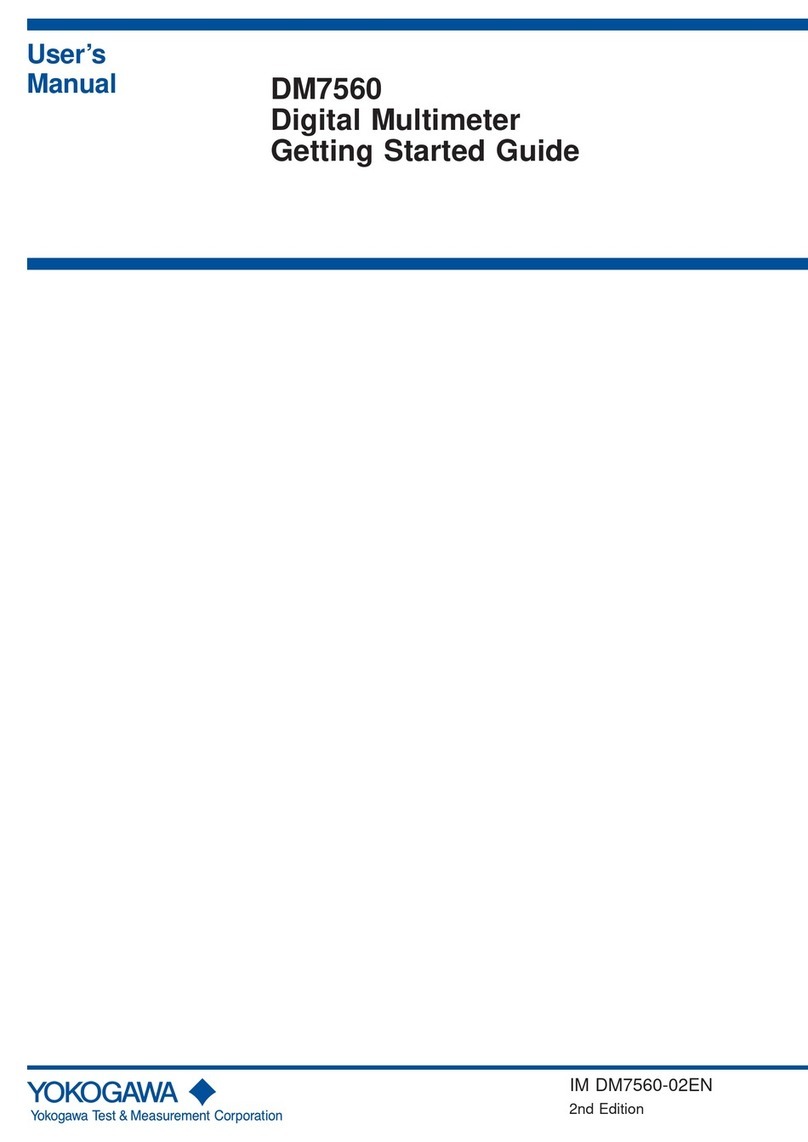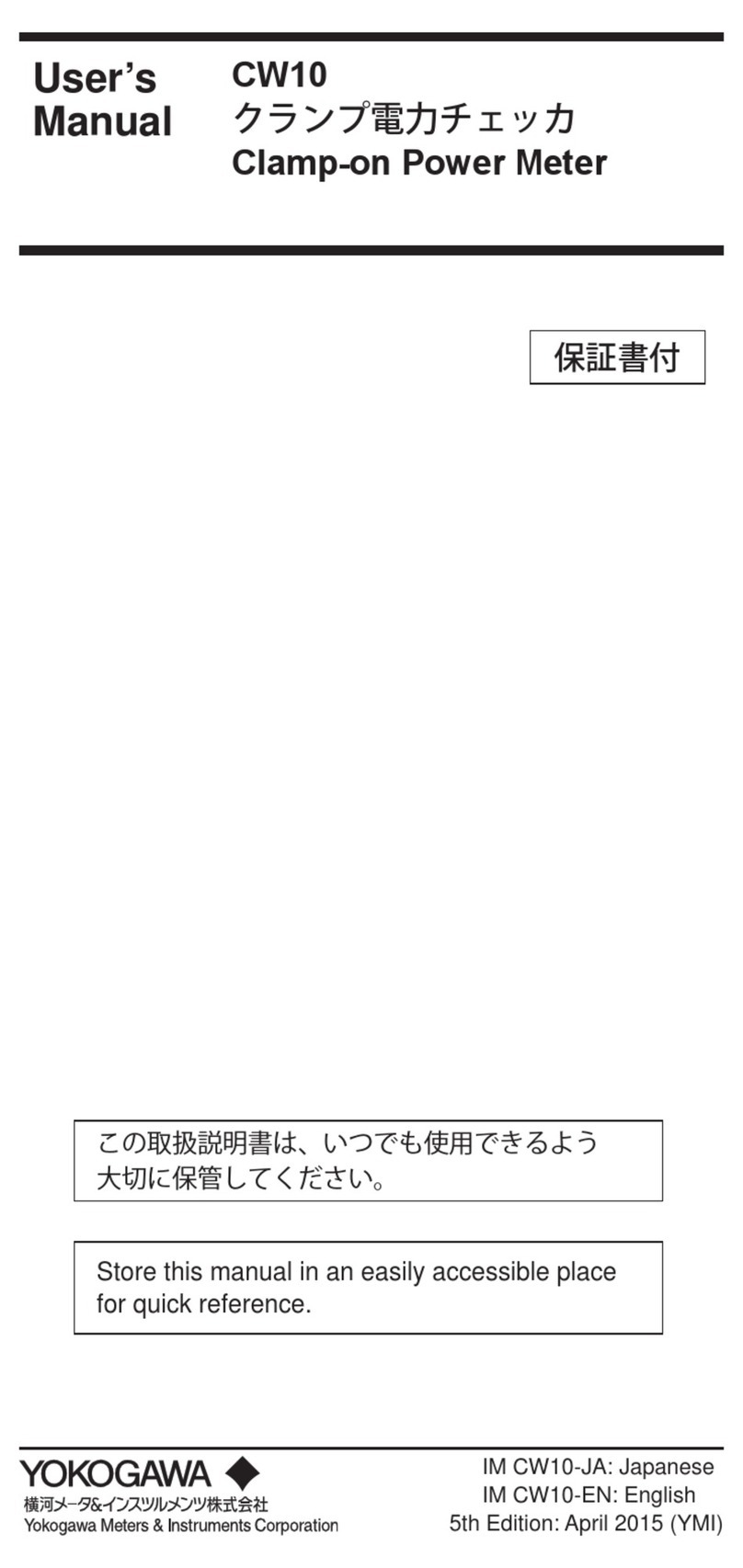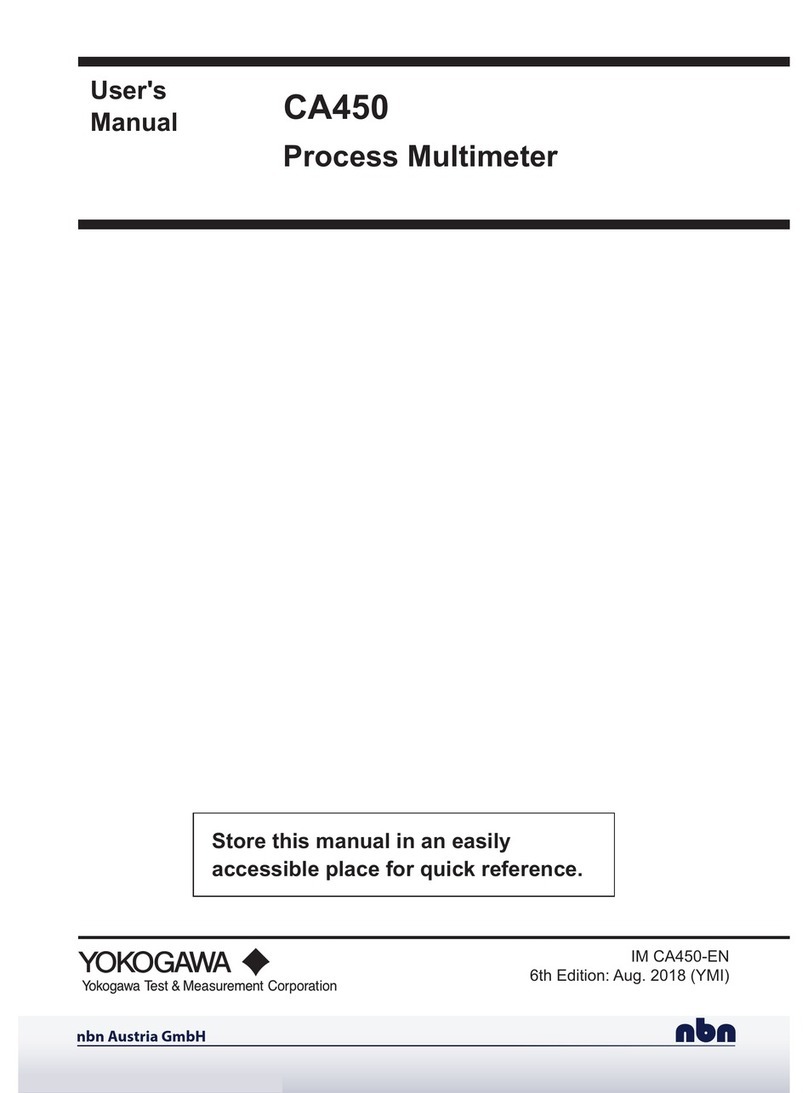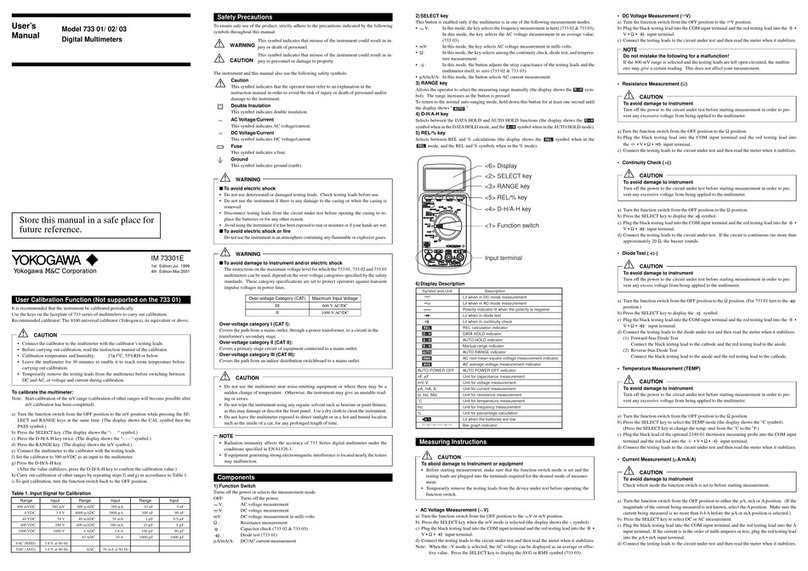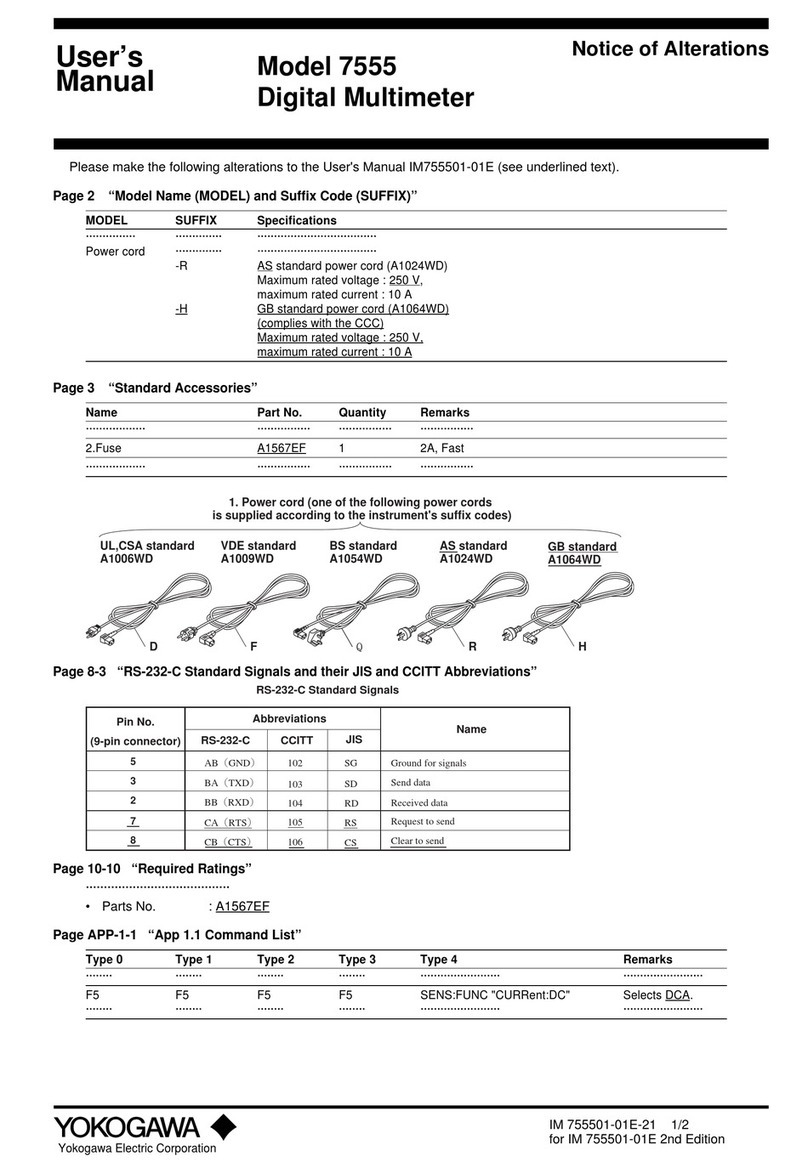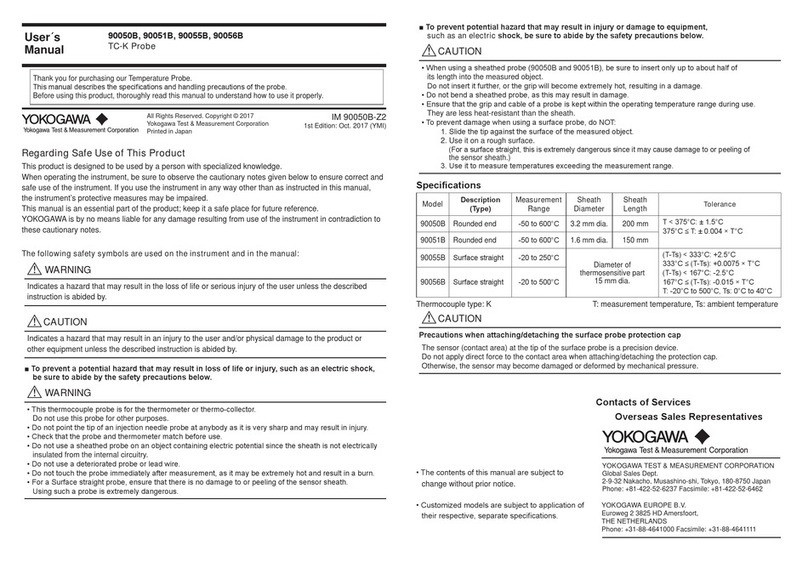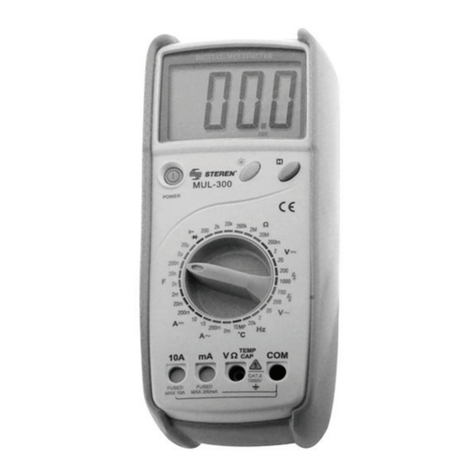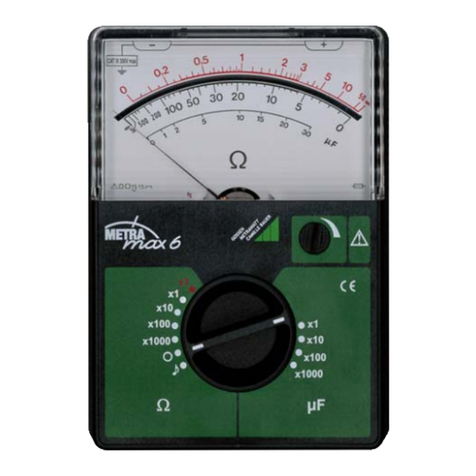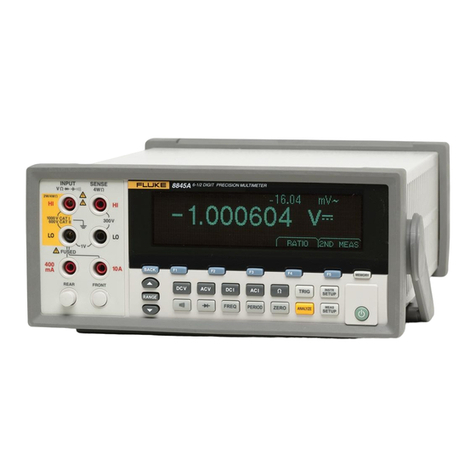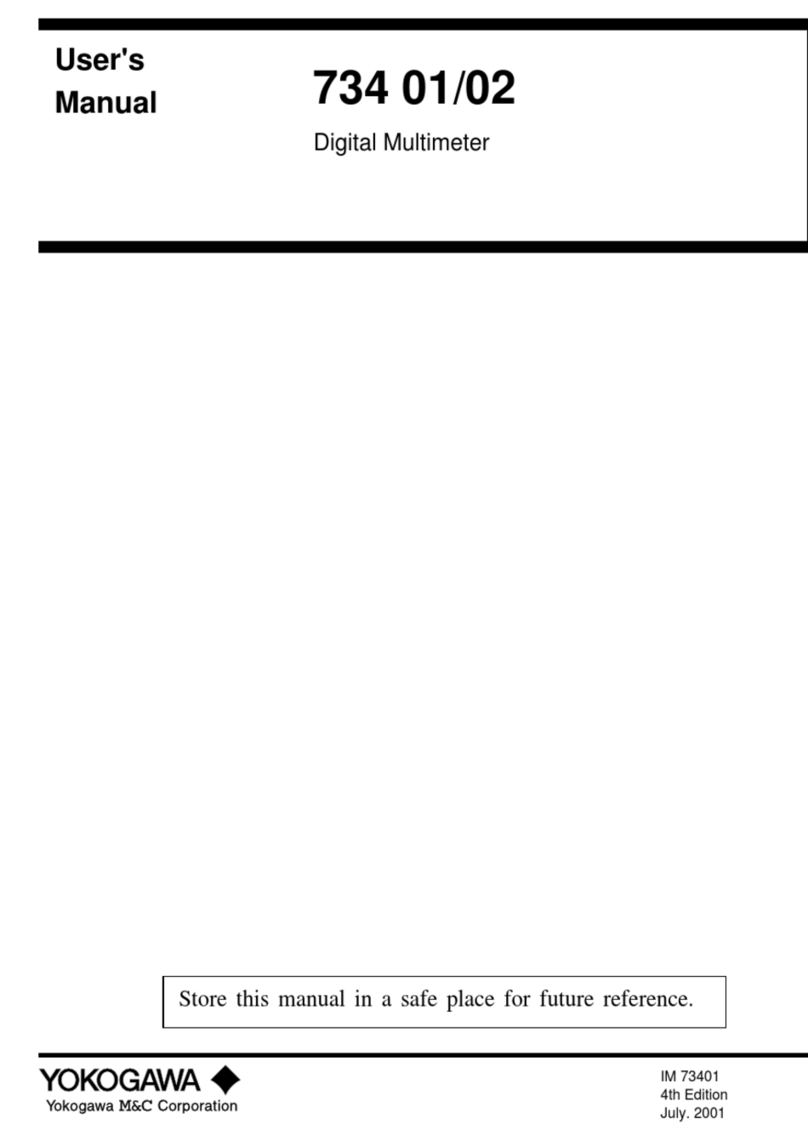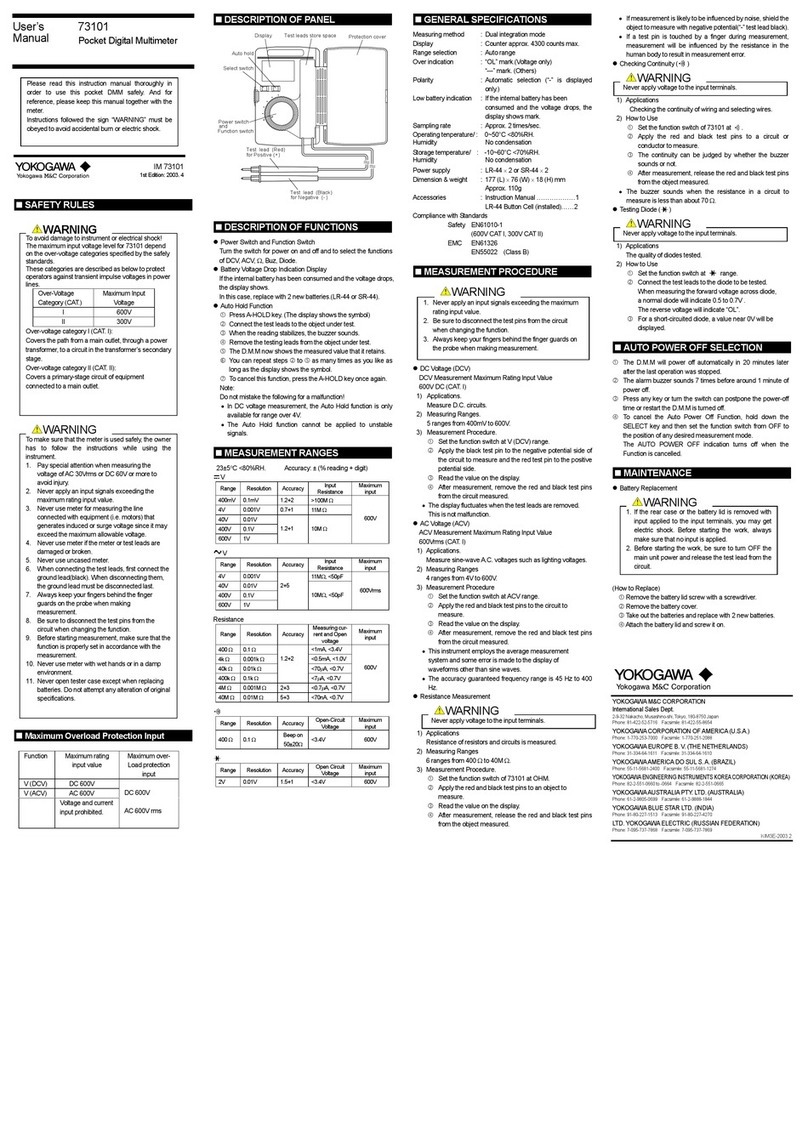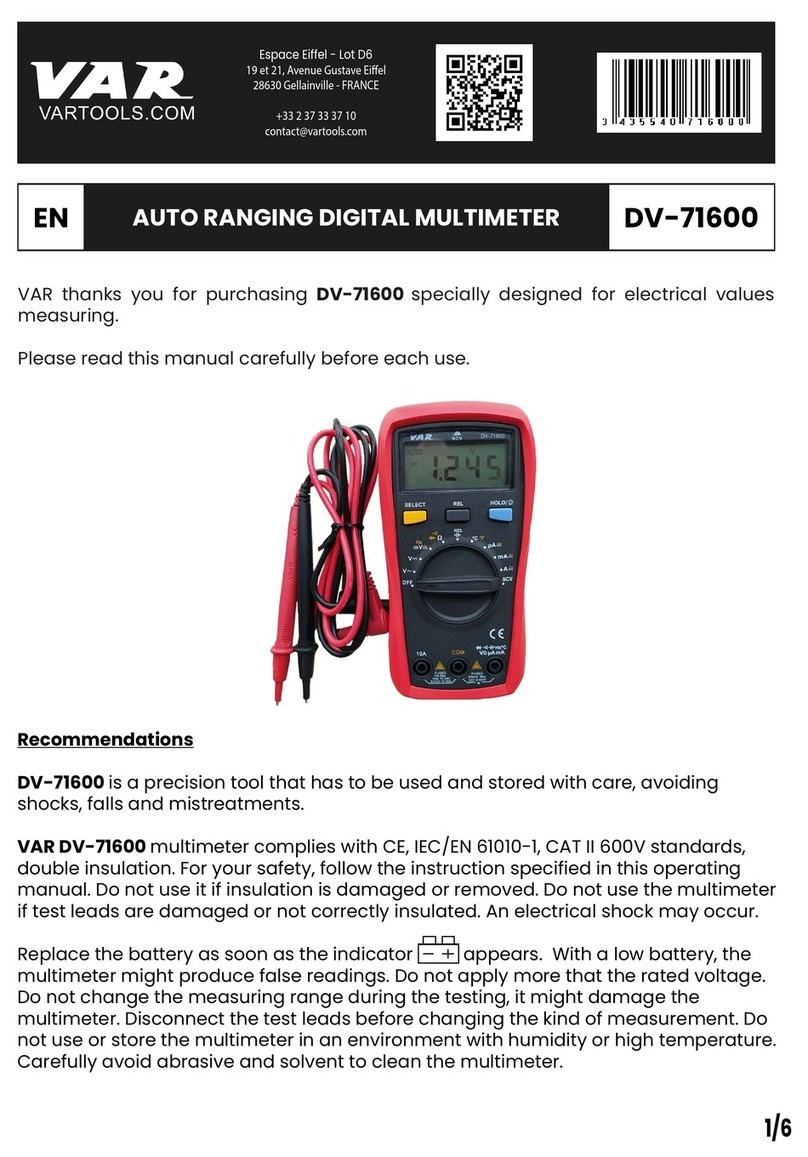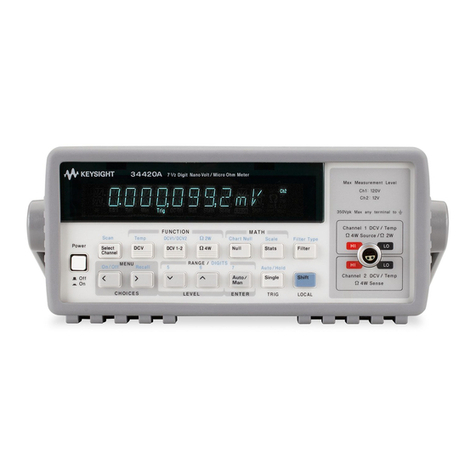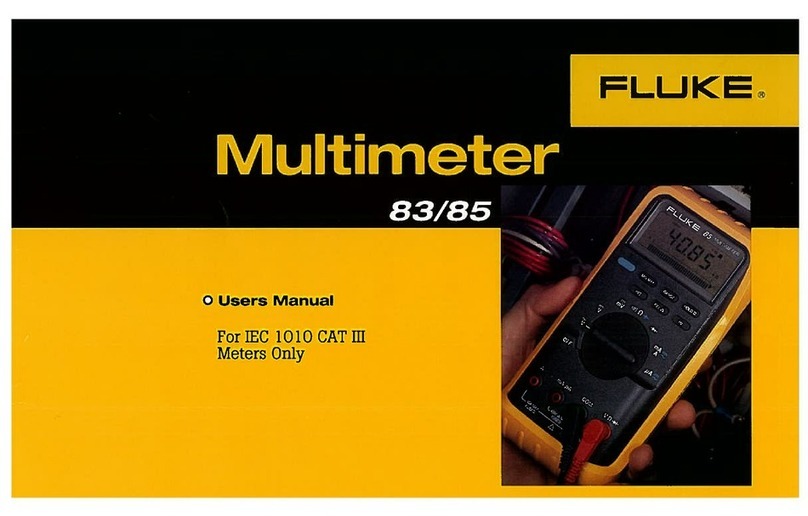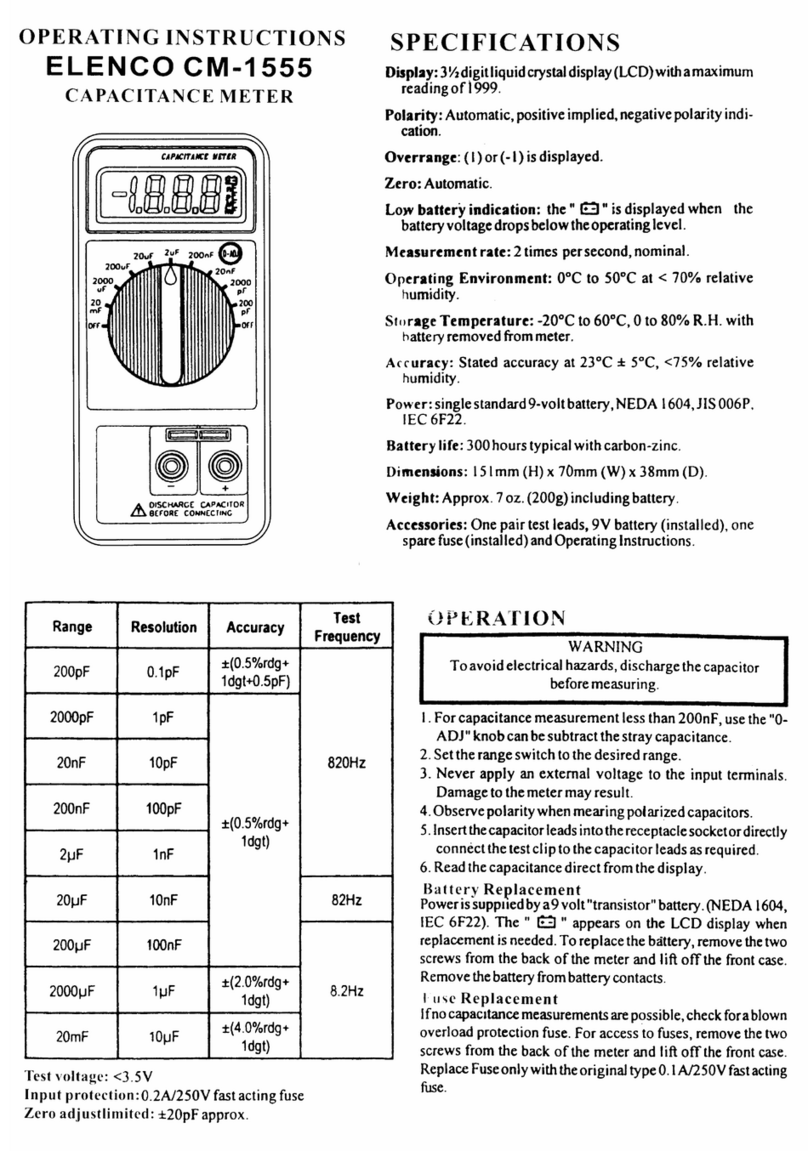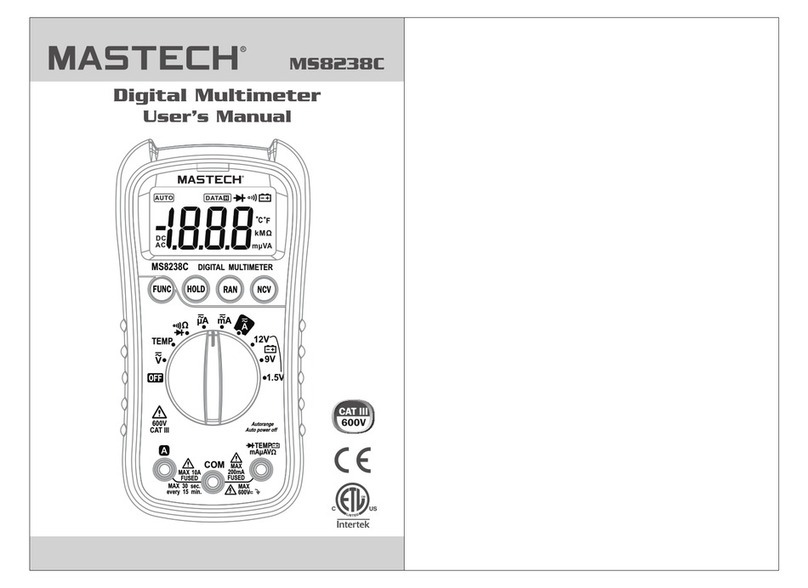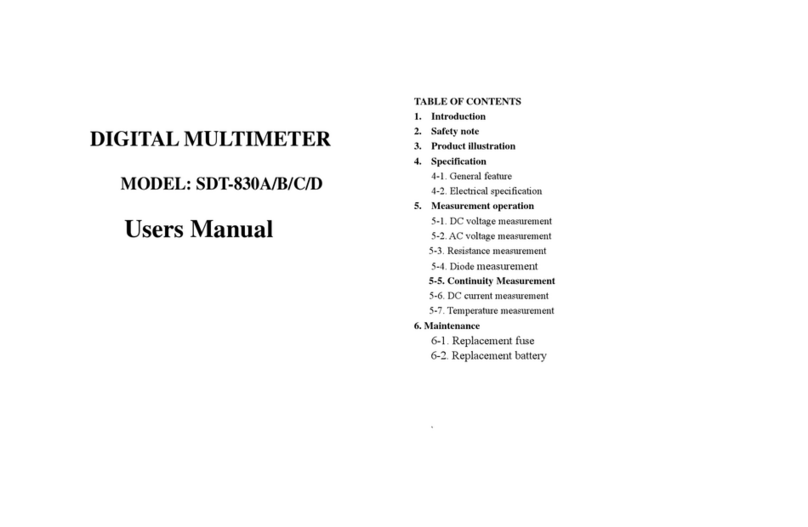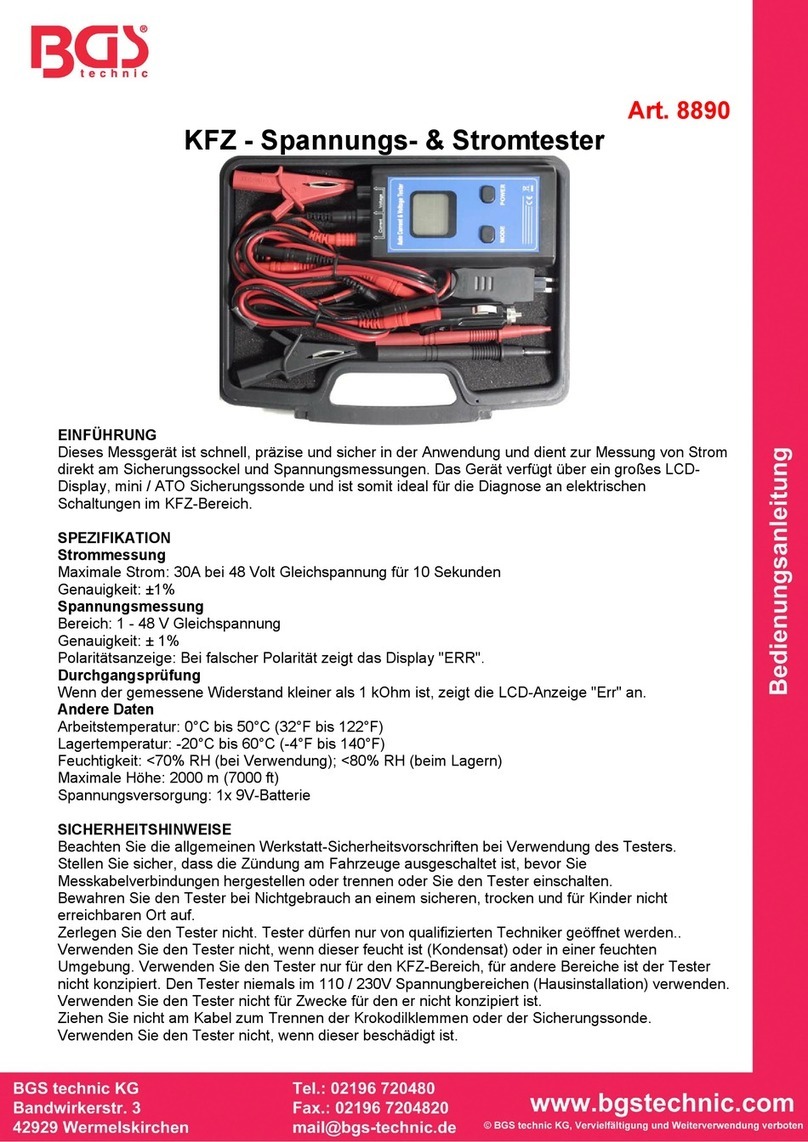
Specifications
1. General Specifications
• Measurement functions: AC voltage, DC voltage,AC current (732 01/02/03), DC current(732
01/02/03), resistance, continuity, diode and capacitance (732 02/03)
• Additional functions: Autohold, manual range selection, over-rangealarm,andAutopower
off.
• Display: LCD display that is capable of indicating a significant reading of up
to 4300 counts along with the indications of the unit and function. It
shows the negative polarity only; no indication is given for positive
polarity. The display also has the OL or over-range and low-
battery alarm indicators.
Note: The most significant reading is 210 counts for the diode test
and 2300 counts for the capacitor check.
• Range selection: Manual or automatic
• Sampling: 2 times/sec
• Operating temperature and humidity ranges:
0 to 50°C (Accuracy guaranteed range: 23±5°C)
Where the range is 0 to 40°C for humidity of 80%RH or less and 40
to 50°C for humidity of 70%RH or less
• Storage temperature and humidity ranges:
-20°C to 60°C; 70% RH maximum
• Battery life: Approximately 600 hours (when continuously operated on alkaline
batteries)
• Power supply: AAA-size batteries (ANSI) .......................................................... 2
• External dimensions: 74 (W) ×155 (H) ×31 (D) mm (excluding protrusions)
• Weight: Approx. 240 g (including batteries)
•Safety standards: EN61010-1:1993 +A2 ; 1995, EN61010-2-031:1994
(AC/DC 300V CAT.III, AC/DC 600 V CAT. II, Pollution degree2)
•EMC standards: EN55011:1998 Group 1 Class B
EN61326-1 ; 1997 +A1 ; 1998
• Effect of EMS immunity:Accuracy range of reading: [Rated accuracy + 5.0% of each range]
for the strength of a radio-frequency electromagnetic field of 3 V/m
• Operable altitude: 2000m or less above sea level.
• Accessories: Batteries (housed in the instrument) .............................................2
Testing leads ............................................................................ 1set
Spare fuse: F05 (500 mA/250 V) ................................................. 1
F02 (15 A/250 V) ...................................................... 1
Instruction manual ........................................................................ 1
2. Electrical Specification
Test conditions: 23 ±5°C at 80% RH maximum
Accuracy: ±(percentage of reading + number of LSD reading)
Note: Each response noted below is a value measured in the Range Hold mode (manual range
setting).
• DCVoltage Measurement ( V)
Input
Resistance Maximum
Input Voltage
Range
400 mV
4V
40 V
400 V
600 V
0.1 mV
0.001 V
0.01 V
0.1 V
1V
0.5%+1 600 V>100MΩ#
11MΩ#
10MΩ
0.5%+1 0.3%+1
0.75%+1
Accuracy
732 01
Resolution
732 02/04
732 03
Response: 1.5 sec maximum for 400 mV range or 1 sec maximum for other ranges
•AC Voltage Measurement ( V) (Mean-value detection and rms-value calibration)
Input
Resistance
Range
4 V
40 V
400 V
600 V
0.001 V
0.01 V
0.1 V
1 V
1%+5 0.75%+5
11 MΩ, <50 pF 600 V
10 MΩ, <50 pF
Accuracy (40-500 Hz)
Resolution Maximum
Input Voltage
732 01 732 02
732 03/04
Response: 2 sec maximum
VmAµAACOM
/
/
4/10
40/400
400/4000
uA
mA
A
V
V
OFF
Red testing lead
Black testing lead
•DC Current Measurement ( A)
*This function is not supported on the 732 04 multimeter.
Voltage
Drop
Range
400 µA*1
4000 µA
40 mA*2
400 mA
10 A*3
µA
mA
A
0.1 µA
1µA
0.01 mA
0.1 mA
0.01 A
1% + 2
2% + 2
400 mA
The input is
protected by a
500 mA/250 V
fuse
10 A
The input is
protected by a
15 A/250 V fuse
<0.17 mV/µA
<3 mV/mA
<0.04 V/A
Accuracy
Resolution Maximum
Input Current
732 01 732 02 732 03
*1, *2 These ranges may produce a readout error equivalent to several times their resolution.
*3 A current of 11 to 20 A can also be measured if the time interval is kept within 30
seconds. The buzzer will sound if the interval exceeds 30 seconds.
Response: 1 sec maximum
•AC Current Measurement ( A)
*This function is not supported on the 732 04 multimeter.
(Mean-value detection and rms-value calibration)
Voltage
Drop
Range
400 µA*1
4000 µA
40 mA*2
400 mA
10 A*3
µA
mA
A
0.1µA
1µA
0.01mA
0.1mA
0.01A
2% + 20
2% + 5
2% + 20
2% + 5
2.5% + 20
400 mA
The input is
protected by a
500 mA/250 V
fuse
10 A
The input is
protected by a
15 A/250 V fuse
<0.17 mV/µA
<3 mV/mA
<0.04 V/A
Accuracy (40-500 Hz)
Resolution Maximum
Input Current
732 01 732 02 732 03
*1, *2 These ranges may produce a readout error equivalent to several times their resolution.
*3 A current of 11 to 20 A can also be measured if the time interval is kept within 30
seconds. The buzzer will sound if the interval exceeds 30 seconds.
Response: 2 sec maximum
• Resistance Measurement (Ω)
Measuring
Current Open-loop
Voltage
Input Protective
Voltage
Range
400 Ω
4K Ω
40K Ω
400K Ω
4M Ω
40M Ω
<1.0 mA
<0.5 mA
<70 µA
<7 µA
<0.7 µA
<70 nA
<3.4 V
<1.0 V
<0.7 V
600 V0.1 Ω
0.001 kΩ
0.01 kΩ
0.1 kΩ
0.001 MΩ
0.01 MΩ
0.75%+2
0.75%+1
2%+1
5%+2
Resolution Accuracy
732 01/02/03/04
Response: 1 sec maximum for ranges lower than the 400 kΩrange, 5 sec maximum for the 4
MΩrange, and 15 sec maximum for the 40 MΩrange
• Continuity check ( )
Input Protective
Voltage
Range
400 Ω0.1 Ω600 V
Open-circuit
Voltage
<3.4 VThe buzzer turns on for
resistances lower than 50 ±20 Ω.
Range of operation
732 01/02/03/04
Resolution
Response: 0.2 sec maximum (for a buzzer response)
• DiodeTest ( )
Input Protective
Voltage
Range
2 V 0.01 V 600 V
Open-circuit
Voltage
<3.4 V
1% + 1 (for measuring currents
smaller than 1.0 mA)
Accuracy
732 01/02/03/04
Resolution
Response: 1 sec maximum
• Capacitor check ( )
Range Resolution
20 nF
200 nF
2 µF
20 µF
200 µF
0.01 nF
0.1 nF
0.001 µF
0.01 µF
0.1 µF
This function
is not
available.
By means of
a 500 mA/250 V fuse
2% + 5 typical
Readings in the 20nF range are
values after zero calibration
has been completed.
Protection FuseAccuracy 732 03732 02732 01/04
Response: 1 sec maximum
VmAµAACOM
/
/
4/10
40/400
400/4000
uA
mA
A
V
V
OFF
Black testing lead
Red testing lead
Black testing
lead Red testing
lead
Red testing
lead Black testing
lead
Figure 1 Forward-bias
Diode Test
Figure 2 Reverse-bias
Diode Test
View with the Casing Open
F02:15 A/250 V
protection fuse
F05:500 mA/250 V
protection fuse
b)
c)
a
•DiodeTest ( )
a) Set the function switch from the OFF position to the position.
b) Plug the black testing lead into the COM input terminal and the red
testing lead into the V•Ω• input terminal.
c) Connect the testing leads to the diode and then read the multimeter
when it stabilizes.
(1) Forward-bias Diode Test
Connect the black testing lead to the cathode and the red testing
lead to the anode (see Figure 1).
Silicon diodes should give a reading of approximately 0.5 V and
light-emitting diodes a reading between 1.5 V and 2.0 V. Note
that readings close to 0 V represent a short-circuit and the "---"
symbol indicates an open-circuit.
(2) Reverse-bias Diode Test
Connect the black testing lead to the anode and the red testing
lead to the cathode (see Figure 2).
Normally, the display shows the "---" symbol, indicating that the
diode under test is normal. The diode is defective if the display
gives a certain voltage level.
d) When the test is complete, set the function switch back to the OFF
position and turn off the multimeter.
•Capacitor Check ( )
*This function is not supported on the 732 01/04 multimeters.
CAUTION
To avoid damage to Instrument or equipment.
Before starting measurement, be sure to discharge the capacitor under check.
a) Set the function switch from the OFF position to the position.
b) Plug the black testing lead into the COM input terminal and the red
testing lead into the µA•mA• input terminal.
c) Press the SELECT key to adjust the stray capacitance to zero (the
display shows the
CAL
symbol).
d) Connect the testing leads to the circuit under check and then read
the multimeter when it stabilizes.
e) When measurement is complete, set the function switch back to the
OFF position and turn off the multimeter.
NOTE
Do not mistake the following for a malfunction!
Zero calibration is only effective when the 20nF range is selected.
•Current Measurement (µA/mA/A)
*This fucntion is not supported on the 732 04 multimeter.
CAUTION
To avoid damage to instrument!
• Check to which mode the function dial is set before starting measurement.
•Acurrent of 11 to 20 A can also be measured if the time interval is kept within 30
seconds. The buzzer will sound if the interval exceeds 30 seconds. If this happens,
immediately stop measurement. To continue measurement, wait for 2 minutes or more
when restart.
a) Set the function switch from the OFF position to either the µA, mA or A position. (If the
magnitude of the current being measured is not known, select theA position.)
b) When measuring AC current, press the SELECT key to select the AC mode. (The display
shows the “ ” symbol to indicateAC-mode measurement.)
c) Plug the black testing lead into the COM input terminal and the red testing lead into the A
input terminal. If the current is in the order of milli-amperes or less, plug the red testing lead
into the µA•mA• input terminal.
d)
Connect the testing leads to the circuit under test and then read the multimeter when it stabilizes.
e) When measurement is complete, set the function switch back to the OFF position and turn
off the multimeter.
VmAµAACOM
/
/
4/10
40/400
400/4000
uA
mA
A
V
V
OFF
mA
mA
Red testing lead
Black testing lead
VmAµAA COM
/
/
4/10
40/400
400/4000
uA
mA
A
V
V
OFF
A
A
Red testing lead
Black testing lead
AUTO HOLD Function
The 732 series of multimeters can automatically retain the measured value when the testing
leads are handled as described below.
a) Press the AUTO.H key. (The display shows the
A • H
symbol.)
b) Connect the testing leads to the object under test.
c) When the reading stabilizes, the buzzer sounds.
d) Remove the testing leads from the object under test.
e) The multimeter now shows the measured value that it retains.
f) You can repeat steps b) to e) as many times as you like as long as the display shows the
A • H
symbol.
NOTE
Do not mistake the following for a malfunction!
•In DC voltage measurement, the AUTO HOLD function is only available for ranges
greater than the 4 V range.
•This function is not available for current-mode measurement.
•In a capacitor check, theAUTO HOLD function requires a few seconds before it takes
effect.
•The AUTO HOLD function cannot be applied to unstable signals.
g) To cancel this function, press the
A • H
key once again.
AUTO POWER OFF Function
The multimeter automatically turns off if no key is pressed for a period of 20 minutes. The
multimeter will beep for approximately one minute to alert the operator before the automatic
power-off function takes effect. (Pressing any key while the multimeter is beeping postpones
the power-off time. Pressing any key once after the power to the multimeter is automatically
turned off switches the multimeter on again.)
To cancel the automatic power-off function, hold down the SELECT key and then set the func-
tionswitch from the OFF to the position of any desired measurement mode. (TheAUTO POWER
OFF indication turns off when the function is canceled.)
To enable the function once again, temporarily switch the function switch back to the OFF
position, and then select the desired measurement mode.
Battery Replacement
If the batteries fall below the normal operating voltage, the symbol turns on. If this
happens, replace the batteries with new ones (AAA-size [ANSI] batteries....2).
CAUTION
To avoid electric shock!
•Be sure to disconnect the multimeter from the circuit under test before replacing the
batteries.
•Replace both batteries at the same time making sure to position them with the correct
polarities.
To replace the batteries:
a) Remove the three screws on the back of the casing.
b) Open the casing.
c) Take the battery holder out of the casing.
d) Replace the batteries with new ones and install the battery
holder back into the casing.
e) Close the casing and fasten it with the three screws.
Fuse Replacement
If a current greater than the rated value flows when the multimeter is in the current-measure-
ment range, a protection fuse may blow. If this happens, replace that fuse. The multimeter
contains the following two types of fuses:
• Type F05 250 V/500 mA fuse
• Type F02 250 V/15 A fuse
CAUTION
To avoid electric shock!
•Be sure to disconnect the multimeter from the circuit under test before replacing the
fuse(s).
•Do not operate the multimeter with the casing left open.
•In order to avoid damage to the multimeter or any possible accident, use fuses of the
specified rating.
To replace the fuse(s):
a) Remove the three screws on the back of the casing.
b) Open the casing.
c) Remove the blown fuse from the fuse holder.
d) Install a new fuse in the holder.
e) Close the casing and fasten it with the three screws.
